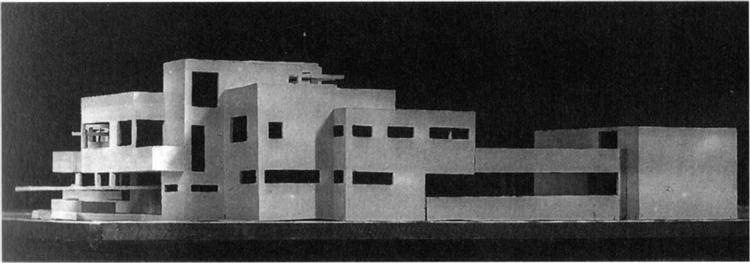Description
The work "Mansion model" of 1923, created by Theo Van Doesburg, is a paradigmatic example of Stijl's movement, which he co-founded and seeks the harmony between art and architecture through the simplification of shapes and a palette of colors minima. Van Doesburg, known for its interdisciplinary approach, addresses in this painting the intersection between architecture and painting, a recurring concept in his work and in the spirit of Stijl.
At first glance, the composition of "mansion model" seems to be a two -dimensional representation of an architectural structuring. The work is presented in a geometric format, where rectangles and straight angles predominate that juxtapose creating a sensation of order and coherence. Each plane is carefully delimited, which reflects a clear intention to decompose reality through the use of a grid of forms. This approach, characteristic of Stijl, seeks not only to represent reality, but also contribute to a new way of seeing the world, more abstract and stripped of superfluous ornamentation.
The use of color in "Mansion model" is equally significant. The artist uses a red, blue and yellow primary colored scheme contrasted with white and black. This choice resonates with the ideas of purity and clarity of the STIJL movement, where color is not only a decorative element, but a compositional tool that helps define the structure and function of the space represented. The interaction between these vibrant colors generates a dynamism that feels almost palpable, offering a sense of movement and life to a representation that might otherwise seem static.
It is remarkable that in "mansion model" there is no human figure that inhabits the space represented. This omission reinforces the notion that the Van Doesburg approach is focused on the architectural space itself, its construction and its potential. Not including characters, the artist invites the viewer to contemplate the work as an autonomous universe, where architecture and art coexist in a kind of spatial dialogue. This approach can also be interpreted as a reflection of the utopian search of Stijl, which aspired to a new way of life that would be embodied in carefully designed spaces.
Attached to these formal aspects, it is important to consider the historical context in which this work was created. Like other pioneers of the STIJL movement, such as Piet Mondrian, Van Doesburg was influenced by the technological and cultural developments of the early twentieth century. The work can be seen as a response to the growing industrialization and urbanization of Europe, a time when modern aesthetics began to establish itself in society.
In the interpretation of "Mansion model", a work is configured that goes beyond simple visual representation; It is a meditation on space, shape and functionality in architecture. This approach has resonated over the years and influenced many contemporary architects and artists who seek to create a dialogue between art and the constructed form.
Theo Van Doesburg, through this work, not only establishes a visible reference in the art world, but also stands as a thinker who prefigures future developments in design and architecture, making "mansion model" a Testimony of his time and his lasting aesthetic vision.
KUADROS ©, a famous paint on your wall.
Hand-made oil painting reproductions, with the quality of professional artists and the distinctive seal of KUADROS ©.
Art reproduction service with satisfaction guarantee. If you are not completely satisfied with the replica of your painting, we refund your money 100%.

